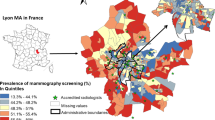Abstract
This study evaluated spatial access to mammography centers in Appalachia using both traditional access measures and the two-step floating catchment area (2SFCA) method. Ratios of county mammography centers to women age 45 and older, driving time to nearest mammography facility, and various 2SFCA approaches were compared throughout Pennsylvania, Ohio, Kentucky, and North Carolina. Closest travel time measures favored urban areas. The 2SFCA method produced varied results depending on the parameters chosen. Appalachia areas had greater travel times to their closest mammography center. Appalachia areas in OH and NC had worse 2SFCA scores than non-Appalachia areas of the same states. A relative 2SFCA approach, the spatial access ratio method, was recommended because it helped minimize the differences between various 2SFCA approaches.





Similar content being viewed by others
References
Anderson, R.T., Yang, T.C., Matthews, S.A., Camacho, F., et al.: Breast cancer screening, area deprivation, and later-stage breast cancer in appalachia: Does geography matter? Health Serv. Res. 49, 546–567 (2014)
Appalachia Regional Commision (ARC). The Appalachia region. http://www.arc.gov/appalachian_region/TheAppalachianRegion.asp. Accessed 10 Oct 2014
Bhanegaonkar, A., Madhavan, S., Khanna, R., Remick, S.C.: Declining mammography screening in a state medicaid fee-for-service program: 1999–2008. J. Women’s Health 21(8), 821–829 (2012)
Blackley, D., Behringer, B., Zheng, S.: Cancer mortality rates in Appalachia: descriptive epidemiology and an approach to explaining differences in outcomes. J. Community Health 37(4), 804–813 (2012)
Dai, D.: Black residential segregation, disparities in spatial access to health care facilities, and late-stage breast cancer diagnosis in metropolitan Detroit. Health Place 16(5), 1038–1052 (2010)
Department of Health and Human Services. Shortage Designation: Health Professional Shortage Areas & Medically Underserved Areas/Populations. http://www.hrsa.gov/shortage/ (2008). Accessed 15 Oct 2014
Freeman, A.B., Huang, B., Dragun, A.E.: Patterns of care with regard to surgical choice and application of adjuvant radiation therapy for preinvasive and early stage breast cancer in rural Appalachia. Am. J. Clin. Oncol. 35(4), 358–363 (2012)
Guagliardo, M.F.: Spatial accessibility of primary care: concepts, methods and challenges. Int. J. Health Geogr. 3, 3 (2004)
Henry, K.A., Boscoe, F.P., Johnson, C.J., Goldberg, D.W., Sherman, R., Cockburn, M.: Breast cancer stage at diagnosis: Is travel time important? J. Community Health 1(36), 933–942 (2011)
Lane, N., Konrad, R., Ricketts, T., et al.: Health Care Costs and Access Disparities in Apppalachia. Appalachia Regional Commission, Washington, DC (2012)
Lengerich, E.J., Tucker, T.C., Powell, R.K., et al.: Cancer incidence in Kentucky, Pennsylvania, and West Virginia: disparities in Appalachia. J. Rural Health 21(1), 39–47 (2005)
Lian, M., Struthers, J., Schootman, M.: Comparing GIS-based measures in access to mammography and their validity in predicting neighborhood risk of late-stage breast cancer. PLoS One 7(8), e43000 (2012). doi:10.1371/journal.pone.0043000
Luo, W., Qi, Y.: An enhanced two-step floating catchment area (E2SFCA) method for measuring spatial accessibility to primary care physicians. Health Place 15, 1100–1107 (2009)
Luo, W., Wang, F.: Measures of spatial accessibility to health care in a GIS environment: synthesis and a case study in the Chicago region. Environ. Plan. B 30(6), 865–884 (2003)
Luo, W., Whippo, T.L.: Variable catchment sizes for the two-step floating catchment area (2SFCA) method. Health Place 18, 789–795 (2012)
Mao, L., Nekorchuk, D.: Measuring spatial accessibility to healthcare for populations with multiple transportation modes. Health Place 24, 115–122 (2013)
McGrail, M.R., Humphreys, J.S.: The index of rural access: an innovative integrated approach for measuring primary care access. BMC Health Serv. Res. 9, 124 (2009a)
McGrail, M.R., Humphreys, J.S.: A new index of access to primary care services in rural areas. Aust. NZ. J. Public Health 33, 418–423 (2009b)
McGrail, M.R.: Spatial accessibility of primary health care utilising the two step floating catchment area method: an assessment of recent improvements. Int. J. Health Geogr. 16, 11–50 (2012)
Paskett, E.D., Fisher, J.L., Lengerich, E.J., et al.: Disparities in underserved white populations: the case of cancer-related disparities in Appalachia. Oncologist 16(8), 1072–1081 (2011)
Pollard, K., Jacobson, L.A.: The Appalachian Region: A Data Overview from the 2008–2012 American Community Survey. Appalachia Regional Commission. (2014) Retrieved from http://www.arc.gov/research/researchreportdetails.asp?REPORT_ID=109
Tao, Z., Cheng, Y., Dai, T., Rosenberg, M.W.: Spatial optimization of residential care facility locations in Beijing, China: maximum equity in accessibility. Int. J. Health Geogr. 14, 13–33 (2014)
U.S. Census Bureau. Centers of Population. https://www.census.gov/geo/reference/centersofpop.html (2014). Accessed 5 June 2014
U.S. Census Bureau. Geographic Terms and Concepts—Place. https://www.census.gov/geo/reference/gtc/gtc_place.html (2014). Accessed 5 June 2014
U.S. Preventive Services Task Force: Screening for breast cancer: U.S. preventive services task Force recommendation statement. Ann Intern Med 151, 716–726 (2009). W-236
Wan, N., Zhan, F.B., Zou, B., Chow, E.: A relative spatial access assessment approach for analyzing potential spatial access to colorectal cancer services in Texas. Appl. Geogr. 12, 291–299 (2012)
Wang, F.: Measurement, optimization, and impact of health care accessibility: a methodological review. Ann. Assoc. Am. Geogr. 102(5), 1104–1112 (2012)
Wang, F., Luo, W.: Assessing spatial and nonspatial factors for healthcare access: towards an integrated approach to defining health professional shortage areas. Health Place 11, 131–146 (2005)
Weeks, W.B., Kazis, L.E., Shen, Y., et al.: Differences in health-related quality of life in rural and urban veterans. Am. J. Public Health 94(10), 1762–1767 (2004)
Acknowledgments
This research was funded by the National Cancer Institute and the NIH Office on Women’s Health through Grant 1 R21 CA168479 (Balkrishnan, PI). The authors would like to acknowledge the suggestions of Drs. Kai Zheng, David Hanauer and Maureen Sartor, all at the University of Michigan who were members of Dr. Donohoe’s dissertation committee.
Author information
Authors and Affiliations
Corresponding author
Ethics declarations
Conflicts of interest
None of the authors have any conflicts of interest to disclose.
Rights and permissions
About this article
Cite this article
Donohoe, J., Marshall, V., Tan, X. et al. Evaluating and comparing methods for measuring spatial access to mammography centers in Appalachia. Health Serv Outcomes Res Method 16, 22–40 (2016). https://doi.org/10.1007/s10742-016-0143-y
Received:
Revised:
Accepted:
Published:
Issue Date:
DOI: https://doi.org/10.1007/s10742-016-0143-y




